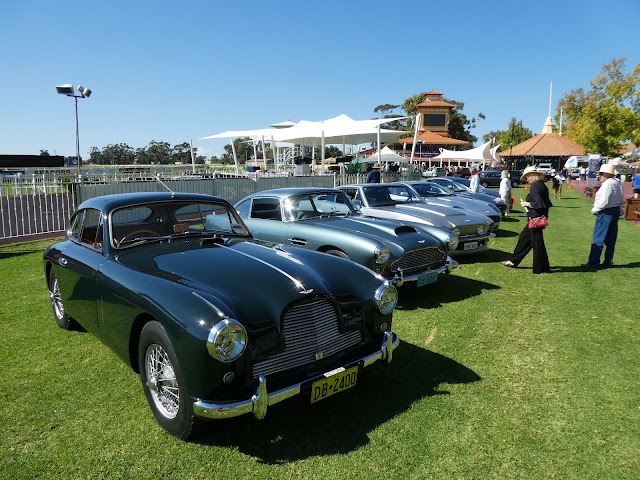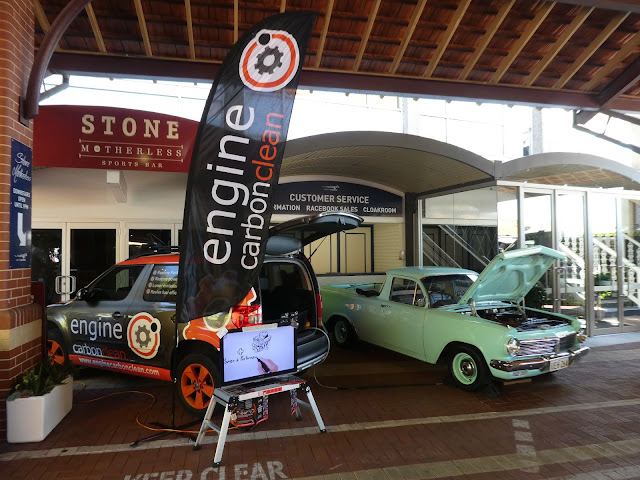
After 24 years at Whiteman Park the Council of Motoring Clubs decided that it was time to make some changes to this year's Classic Car Show. Lack of change had led the show to stagnate somewhat with a slowly declining attendance of both exhibitors and visitors. After reviewing several prospective venues Ascot Racecourse in Belmont was selected.
The choice was inspired as there was sufficient space for 1000 cars, trader exhibitions as well as better onsite facilities, toilets, shade and food. There was great enthusiasm for the new show from the clubs and the venue's entire space was booked out.

The Council of Motoring Clubs is a volunteer organization and events like this don't just happen. As I was enthusiastic about the change I volunteered to assist the organizing committee. Shortly after we started work I was voted chairman of the organizing committee. I must thank everyone who helped out and volunteered their time. Without their efforts, the show would never have been the success it was.
Thanks must also go to our show sponsors:
- Shannon's Insurance https://www.shannons.com.au/
- Richard's Tyrepower www.richardstyrepower.com.au/
- Car Stereo Shop https://carstereoshop-com-au.myshopify.com/
- AutoPower Car Paint Centre http://autopower.com.au/
- Perth Racing https://www.perthracing.org.au/
- Media Junction / Type Express http://www.typeexpress.com.au/
- City of Belmont www.belmont.wa.gov.au/
Numbers were down this year, probably because thunderstorms were forecast for the day, which always scares off classic car owners, but it was a great first venture. We have lots of great ideas for next year's show which promises to be bigger and better!
Here is random sample of photos from the day. I've used a couple of photos from other photographers who shared their photos on our Facebook page. More photos and comments can be found here: https://www.facebook.com/events/1098484103630857/

Ascot racecourse proved itself to be a terrific location for a car show, with lots of shade and onsite facilities.

Arriving visitors were greeted by an impressive display by the Corvette Club of WA and the National Corvette Restorers Club. corvettesofwa.com/

http://www.ncrs.com.au/

Daimler Lanchester Owners Club https://www.facebook.com/Daimler-Lanchester-Owners-Club-of-WA-618243435018486/

Fiat and Lancia Club www.fiatlancia.org.au/

A fine day for a car show

In front of the Grandstand a display by the Aston Martin Club and Mercedes-Benz Club

Aston Martin Club http://www.amoc.org/

Rolls Royce's in front of the grandstand www.rrocwa.com/

A pair of fine vintage Rolls Royce Phantoms

Roger Fry's exceptional 1934 Phantom II


Austin-Healey Club

http://www.austinhealeywa.org.au/

In the Bookies Hall was a display of Lotus' by Autostrada Luxury Vehicles auto-strada.com.au/

Display by Engine Carbon Clean http://www.enginecarbonclean.com/

Car Stereo Shop https://carstereoshop-com-au.myshopify.com/

Fabcar http://www.fabcar.com.au/

In the Members car park, the Mustang Club http://wa.mustang.org.au/ and West Coast Commodores http://westcoastcommodores.com/index.php?cat=1

The display of the day was put on by the Holden Torana GTR XU1 club. http://www.gmh-torana.com.au/ The line of cars with their bonnets up was very impressive.

1949-59 V8 Ford Club https://www.shannons.com.au/club/carclubs/1949-1959-ford-v8-owners-club-wa/

The heavies of the Historic Commercial Vehicle Club https://www.hcvc.com.au/

English Ford Club https://www.shannons.com.au/club/carclubs/classic-english-ford-club-of-wa-inc/

Cobra Owners Club of WA http://cobracarclubwa.com/

Austin Motor Vehicle Club of WA

After the Second World War British motoring companies were advised to 'export or die!' and the Austin Motor Company took the plunge with ill considered enthusiasm. Austin aimed to break into the US sports car market but their first attempt, the Austin Atlantic, fell absolutely flat in the US. The poor Atlantic, whose styling was quite pleasing for the domestic market, held no appeal for American customers. Not one to give up, Austin developed the cute little Austin Metropolitan, which was sold in the US as the Nash Metropolitan, but once again the car failed to sell. With cars like the Atlantic and Metropolitan British auto manufacturers demonstrated that they really had no idea what the American customer wanted.

An Austin Sheerline on the right

The cute Austin A40 was a British 'people's car'

Austin K2/Y military ambulance in desert campaign finish. A terrifically detailed restoration.

EH Holden Club of WA http://ehcarclubwa.org.au/

FB & EK Holden Club of WA http://www.fbekwa.com.au/

Vauxhall Club

Jaguar Club

Mini Owners Club

Buick Car Club of WA http://www.westernbuicks.org/

Buick Club



The car show's principle sponsor, Shannon's Insurance beside the WA Police drag car "Beat the Heat". Shannon's is the go to company for classic motor vehicle insurance. https://www.shannons.com.au/

Vintage Motorcycle Club of WA. It was pleasing to see a VMCCWA presence at the Classic Car Show after an absence of many years. www.vmccwa.com/

Unfortunately we were competing with a vintage motorcycle festival in York that weekend so attendance was down on expectations.

The Honda C70 Dream was Honda's first real export motorcycle and laid the foundation for Honda's later success. Many features of the motorcycle was copied from German companies such as Zundapp and Puch without apology. Honda's great success was building a bike that actually worked and did not need much in the way of maintenance. It wasn't long before customers in the UK were abandoning their leaking, high maintenance and poorly built British bikes in favour of the cheap, reliable, Japanese machines.

Model A Ford Restorers Club of WA http://modelafordclub.com.au/

Ford Model A Restorers display

Veteran Car Club of WA display

The oldest car at the show, a 1907 Franklin. Franklin were notable for their early adoption of air cooled engines.

A pair of Studebakers

MG TC

My favourite car in the show was this America La France roadster. America La France built (and still build) fire engines. Some of the old veteran and vintage chassis were converted into Edwardian style roadsters after their retirement, such as this one. Everything about the car is massive. The wheels, the tyres, the chain drive, the engine. It's a beast!

This shot provides a little perspective



Ford Escort and BMW

Saab 96 Monte Carlo. This rare car is for sale.

Jensen Motor Association of WA http://jensenclub.weebly.com/

TVRs attending with the Jensen Club

Peugeot 404

A great display by French and Fantastic http://frenchandfantastic.com.au/

Citroen Traction Avant and 2CV

Renault 4CV

Citroen Traction Avant

Looking back on the French and Fantastic array

Renault Alpine

Panhard 24. This recent import from the UK is an extremely rare car in Australia

DKW 3=6, Chevrolet Corvair and NSU Ro80

Citroen DS and Volvo P155

The SIVA display included a small collection of two wheelers

The Classic Gasoline guys do a bit of maintenance work on the Citroen H van

Nobel 200


Volvo P155

DKW, Chevrolet Corvair and NSU Ro80

NSU's radical rotary engined Ro80. A fantastically modern car that still looks contemporary despite being built in 1967.

Messerschmitt KR201 roadster

NSU Prinz IV and a Polish Niki

Simca 1000 and NSU Prinz show considerable similarity in their overall design


NSU Prinz 1200

DKW F94

Citroen H van










